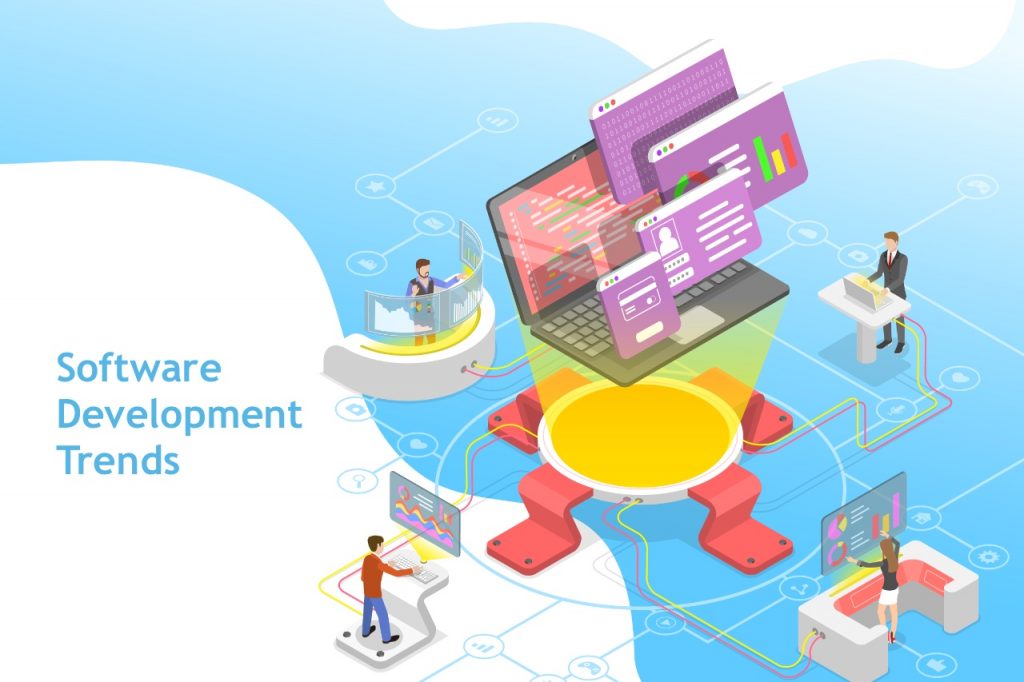From in-house to offshore software teams, staying on top of the newest trends is an excellent way to future-proof a business to ensure it keeps up with what’s popular while also providing quality work.
The Most Impactful Software Development Trends Today
The following are just a few examples of the trends that are catching the software development community’s attention and how they will start to (or continue to) cause major waves in the world of tech itself.
Creative Solutions With the Help of Cutting-Edge Platforms
Oftentimes, developers must figure out a way to build something out of nothing with their coding skills. Cloud computing, microservices, and APIs now give software devs a network for logistics that supports important back-end infrastructures and helps with front-end user experiences. This means that devs have the ability to use these existing solutions instead of burning the midnight oil to create something totally new on their own with raw code. These creative solutions help focus more on the product’s final outcome rather than bugs in the code and other common problems.
DevSecOps
DevSecOps focuses on developer access to the entire code stack and the possible implications of this access in the future. Broad permissions assigned across development teams sometimes lead to mass destruction either at the hands of an insider threat or by a simple mistake. Teams who approach coding with a DevSecOps methodology monitor activity and access to ensure that developers have the least permissions necessary to complete their jobs successfully. This helps keep the devs from making an accidental costly mistake or having access to act as an internal threat.
Native Mobile Development Languages and Design
Now that a large majority of website visitors only see websites via their mobile devices, mobile-first development approaches are highly requested. Thus, this software development trend is gaining popularity with time. New, trendy mobile development languages such as Swift and Kotlin focus on improving the speed of the website or app while improving memory safety and parallelism. This approach will help developers as the demand for personalization, speed, and overall application or mobile site quality continues to grow. As a significant number of people use their smartphones for everything from shopping and connecting with friends to reading content and booking appointments, the trend of intuitive mobile-friendly or mobile-first design will only continue to have more of an emphasis on mobile development.
Low-Code Development
Traditional software development requires teams of dedicated coders, software engineers, and computer science experts to bring programs to life. This makes software development an expensive and time-consuming process. Low-code development changes things up to make it easier and less costly to create unique software. Low-code development helps devs code applications through graphical user interfaces instead of working with rather complex programming languages. Rather than the need for hand-coding every single piece of an application, low-code dev platforms offer drag-and-drop functionality to help visualize applications without getting stuck in the coding weeds.
Proactive Security and Compliance
In the past, security and compliance practices have mostly been reactive to remediate security problems after they already exist. The new approach is a “shift left” from this reactivity to proactivity instead. Engineers and developers work with security professionals to proactively identify the security issues before deployment or any incident occurs.
Virtual or Remote Workforces
Many companies have started to offer remote work as a permanent option due to the global pandemic. However, a distributed workforce in the dev world sometimes presents challenges in terms of productivity and collaboration. While programs exist to help with teamwork across locations, companies have realized that generalized tools don’t always suit an organization’s unique styles and workflow. Devs will help build technologies to keep employees engaged and productive while working virtually by producing software solutions to solve the inherent challenges that come with remote work.
Summing Up
We should go with the latest software development trends. These trends and changes have already started to work their way into the world of software development and general technology. As time progresses, they will only continue to grow in popularity to eventually become the industry standards – until they’re replaced once more, that is. While we can’t predict the future with certainty, chances are in favor that in-house development teams and outsourcing companies should definitely keep an eye out for these trends and their impact on technology.
